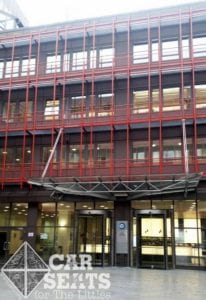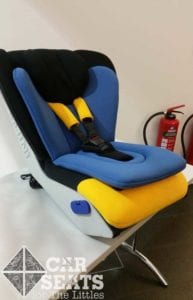It’s not every day that we have a chance to send our team to international child passenger safety conferences, so when the International Conference “Protection of Children in Cars” popped up on our radar, we were thrilled to be able to send one of our EU admins to the event!
The conference took place in Munich, Germany, from December 7th-8th 2017, with a pre-conference workshop on the 6th.
This was an exciting opportunity to join 160 other participants from around the globe. They traveled from as far away as Japan and Canada, and the jolly ol’ US of A! There were representatives from the likes of Transport Canada, Insurance Institute for Highway Safety (IIHS), the Children’s Hospital of Philadelphia (CHOP), Euro NCAP, ANEC, Volvo Sweden, and many more.
Despite the wide range of participants, the conference language was English.
The conference included over 20 presentations. Unlike conferences that United States-based admins attend where a few topic tracks are presented, this conference had just one set of presentations, all of which were focused on child passenger safety. The topics ranged from rear facing car seats and their history to i-Size, to the results of studies, and more.
15th International Conference Protection of Children in Cars
The conference organizers describe the event thusly:
The Conference 2017 is dedicated to review the past and the future of CRS development. What has been achieved in the past and is now international state of the art and which are the concrete tasks of the future in regulation, product Innovation and consumer acceptance. Are different strategies needed in countries with high CRS awareness and countries with emerging CRS use? Which benefits are still to be expected by technical innovation and which permanent safety campaigns are necessary to promote consumer behaviour. This will also be in the focus of the panel discussion on the first conference day.
We were especially interested in the efficacy of booster seat design on the response of the Q6 ATD in simulated frontal sled impacts session.
Here’s a rundown of each day’s highlights:
Day One: 7th December 2017
The conference started off after everyone had a chance to enjoy the wonderful refreshments provided by the venue! Prof. Dr. Klaus Langwieder from the German Insurance Association Institute for Vehicle Safety offered a warm welcome to open the sessions.
Our first presentation of the day was by Pierre Castaing from Euro NCAP. He went over the process of establishing criteria for ECE R129 Phase 3 (i-Size), the new European safety standards, and the different steps/challenges involved in that process.
Jessica Jermakian, from the Insurance Institute for Highway Safety (IIHS), spoke about booster seats on the United States market. She mentioned the new
JASPER, a 3D printed dummy who comes with sensors on the chest for even more accurate results. Jasper stands for Juvenile Anthropomorphic Seat-belt Position Evaluation Rig.
Lotta Jakobsson from Volvo Cars Sweden gave a very detailed presentation about rear facing child seats — past, present, and future. She provided photos of the very first extended rear facing seats available in Sweden back in the 1960s, and it was fascinating to see how different they looked from today’s car seats! I walked away with the staggering statistic – between the years of 1992 and 2011, Sweden had 15 fatalities of children in rear facing car seats, 2 in infant seats, and 13 in toddler seats. These fatalities occurred in situations where there were fire/drowning, intrusion at the place of child, high severity or failure of the child restraint. This study reaffirmed that rear facing is the way forward.
Suzanne Tylko from Transport Canada and a team from PMG Technologies presented the ATD (crash test dummy) measurements to help better describe the kinematics of a 6 year old restrained with the vehicle seat belt. We were perhaps the most interested to hear these results out of all the sessions.
Ms. Tylko presented on behalf of her colleagues. She showed a variety of crash test videos of different booster set ups and crash scenarios, with the resulting data. Our biggest takeaway from this session is that the further the lap belt is down on the thighs, the more movement/excursion before the hip is engaged. We’ve previously explored what a proper belt fit looks like: this study affirms that belt fit is crucial to booster effectiveness.
Day Two: 8th December 2017
The second day of the conference kicked off promptly after more generous refreshments!
The presentations started off with a study done by Suzanne L. Cross, and a team from Monash University in Australia. Their paper “How do child occupants really behave during motor vehicle travel?” reports an extensive and in-depth study where the researchers studied families who had volunteered to have cameras and microphones installed in their vehicles.
The study identified “optimal” and “suboptimal” positions for children in child restraint systems. “Optimal” was defined as the child being within the headwings of the child restraint, sitting correctly in a booster. “Suboptimal” was defined as the child’s head or ears being outside the headwing protection.
The study found that toys and handheld electronic devices caused the child to move to a suboptimal position within the restraint. Conversation, or not interacting with anyone or anything caused an optimal position. This prompted the question — should sled testing in Sweden be done with the dummies in a suboptimal position to start with?
The next presentation was related to the first presentation of the day. Katarina Bohman from Volvo Cars, SAFER (SE) presented on behalf of an international team. Their study concerned the HIII 6y Child ATD crash test dummy in frontal crash tests. Ms. Bohman showed crash tests along with the accompanying data of the HIII6y dummy seated in a booster seat, in a variety of “optimal” and “suboptimal” positions. The results confirmed that a “suboptimal” position, which was defined as the head/ears not within the headwings could increase head excursion.
Efficiency of Booster Seat Design on the Response of the Q6 ATD in Stimulated Frontal Sled Impacts
The next study was in a lot of ways the main event. Aditya Belwadi from Children’s Hospital of Philadelphia’s Center for Injury Research and Prevention presented his team’s paper on the “Efficiency of booster seat design on the response of the Q6 ATD in stimulated frontal sled impacts”. The presentation began with a definition of the different types of booster seats used in this study — high back, backless and heightless. The first heightless booster seat entered the market last year and we were eager to see how this product performed in this study.
Dr. Belwadi showed videos and data from different frontal crash tests. These were conducted on the 2017 FMVSS 213 Test Bench (which Dr. Belwali noted was made with 20% stiffer foam), with the “Q6 ATD with Abdominal Pressure sensors and Hip Liner.”
The selection of booster seats included high back and backless booster seats from the IIHS “best fit” and “check fit” list — one of each. The results reaffirmed that a 6 year old child is definitely safer in a booster seat compared to nothing, despite what local laws may state. A low lap belt fit may cause the child’s pelvis to engage later, meaning the hips move forward before the seat belt engages properly. This is why it’s important to know what a correct seat belt fit looks like.







